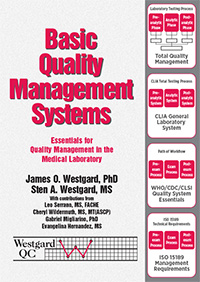
Basic Quality Management Systems
2014, 290 pages, 6 x 9 perfect-bound
ISBN13: 978-1-886958-28-9
ISBN 1-886958-28-9
written by James O. Westgard, PHD and Sten Westgard, MS
With contributions from Leo Serrano, MS, FACHE, Cheryl Wildermuth, MS MT(ASCP), Gabriel Migliarino, PhD, and Evangelina Hernandez, MS
Download a free TOC and excerpt of the book
- 17 Chapters
- Index
- Discussion of all ISO 15189, CLIA General Laboratory System Regulations, WHO/CDC/CLSI guidelins
- Practical guide to the CLSI guidelines, ISO standards, CLIA Final Rules as well as Accreditation Requirements
- Demonstration of Two laboratories that implemented ISO 15189 QMS
Compliance is no longer enough
It's become clear in the US that the CLIA final rules set too low a bar. For laboratories that want to compete, thrive, and distinguish themselves from their competition, they need to strive for a higher level of quality. A Quality Management System is the next level of quality that differentiates the best labs from the rest of the pack.
What's a laboratory to do?
In this vital new manual, Dr. James O. Westgard, sorts through all the ISO standards, CLSI guidelines, WHO and CDC recommendations, as well as the trends and fads, distilling Quality Management Systems into something less fuzzy and more concrete. With practical step-by-step directions, laboratories can begin their QMS journey immediately
Here are just some of the topics covered:
- Deming's "Plan-Do-Check-Act" cycle - the fundamental building block for developing scientific quality managment processes
- Three-stage implementation model focusing on management requirements, technical requirements, and inspection/accreditation
- Application of a Six Sigma Quality Management System, using the powerful tools and concepts from the Six Sigma movement to accelerate QMS implementation
- Introduction of Westgard Sigma Rules™ as a simpler approach for matching the QC needed to the performance of the method
- Introduction of Sigma Proficiency Assessment Charts as a Quality Monitor for External Quality Assessment and Proficiency Testing programs, enabling the estimation of measurement uncertainty
- Examples of real-world laboratories that have implemented ISO 15189 QMS both in the US and abroad
So do I really need to understand Quality Management Systems?
Rather than making an uncoordinated set of attempts to assure quality, the Quality Management System unifies, systematizes, and standardizes Quality in the medical laboratory. It heightens Quality Management to the level of organizational culture. It ingrains the correct practices into the entire staff. While this seems like a tall order, Dr. Westgard shows practical ways to implement indicators, checklists, and benchmarks to achieve this level of quality.
Table of Contents | |
| I: Basic Quality Management Systems for Regulation and Accreditation | |
| 1. Understanding Quality Management Systems | 1 |
| 2. Reviewing QMS Essentials | 11 |
| 3. Focusing on ISO 15189 | 23 |
| 4. Preparing for QMS Implementation | 37 |
| 5. Implementing Management Requirements | 59 |
| 6. Implementing Technical Requirements | 79 |
| 7. A Lab's Journey to CAP-ISO 15189 Accreditation | 95 |
| II. Six Sigma Quality Management Systems for Examination Procedures | |
| 8. Developing a Scientific Quality System | 107 |
| 9. Defining Quality for Intended Use | 131 |
| 10. Selecting an Examination Procedure | 145 |
| 11. Validating Performance of an Examination Procedure | 159 |
| 12. Defining Statistical QC Procedures | 171 |
| 13. Formulating Total Quality Control Plans | 189 |
| 14. Monitoring Nonconformities | 207 |
| 15. Measuring the Uncertainty of Measurements | 223 |
| 16. Managing Quality in the Real World | 239 |
| 17. Improving Quality in the Real World | 245 |
| Index | 285 |
